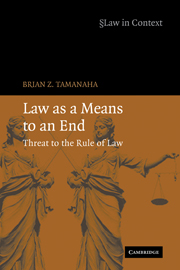Book contents
- Frontmatter
- Contents
- Acknowledgments
- Introduction
- Part 1 The spread of legal instrumentalism
- Part 2 Contemporary legal instrumentalism
- 6 Instrumentalism in legal academia in the 1970s
- 7 Instrumentalism in theories of law
- 8 Instrumentalism in the legal profession
- 9 Instrumentalism of cause litigation
- 10 Instrumentalism and the judiciary
- 11 Instrumentalism in legislation and administration
- Part 3 Corroding the rule of law
- Epilogue
- Index
- Titles in the series
6 - Instrumentalism in legal academia in the 1970s
Published online by Cambridge University Press: 25 July 2009
- Frontmatter
- Contents
- Acknowledgments
- Introduction
- Part 1 The spread of legal instrumentalism
- Part 2 Contemporary legal instrumentalism
- 6 Instrumentalism in legal academia in the 1970s
- 7 Instrumentalism in theories of law
- 8 Instrumentalism in the legal profession
- 9 Instrumentalism of cause litigation
- 10 Instrumentalism and the judiciary
- 11 Instrumentalism in legislation and administration
- Part 3 Corroding the rule of law
- Epilogue
- Index
- Titles in the series
Summary
An instrumental view of law is so taken for granted today that it rarely evokes comment, but in the 1960s and 1970s its novelty in legal education was recognized and prompted expressions of concern. A brief discussion of the legal process school will set the stage for this pivotal period in legal academia. Legal process thought represented the mainstream consensus view of law within the legal academy in the period from the Realists through the 1970s. Although it fell into rather sudden disfavor decades ago, for reasons that will be recounted, it has been claimed, with justification, that legal process thought “has dominated legal scholarship for the last fifty years.”
The legal process approach accepted many of the insights of Legal Realism while offering answers to its most threatening implications. Legal Realism was silenced by the collective reaffirmation during World War II of the goodness of the American legal system in contrast to the evil legal regime of Nazi Germany. Law in the United States is more than raw state power, many argued. The need for moral and legal legitimacy was equally pressing at the height of the Cold War, faced with the threat of Soviet communism. For the reasons elaborated at the end of Chapter 4, however, relativist views had spread within intellectual circles during the 1930s and 1940s, making it difficult to identify and defend universal or objective moral or legal principles.
Democracy became the defining characteristic that distinguishes a free society from a totalitarian one.
- Type
- Chapter
- Information
- Law as a Means to an EndThreat to the Rule of Law, pp. 101 - 117Publisher: Cambridge University PressPrint publication year: 2006

